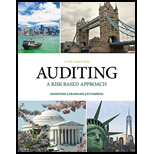
Introduction:
The reports generated by a company that exhibit the financial performance during a particular period of time and show the financial position at a point of time.
Requirement 1
To describe:
For the disclosed risk factor, identify the relevant account that may have an effect on the balance. And for each such account, point out the effect on the audit evidence, and also the specific assertion that the auditor is primarily concerned about.
Introduction:
The reports generated by a company that exhibit the financial performance during a particular period of time and show the financial position at a point of time.
Requirement 2
To describe:
For the disclosed risk factor, identify the relevant account that may have an effect on the balance. And for each such account, point out the effect on the audit evidence, and also the specific assertion that the auditor is primarily concerned about.
Introduction:
The reports generated by a company that exhibit the financial performance during a particular period of time and show the financial position at a point of time.
Requirement 3
To describe:
For the disclosed risk factor, identify the relevant account that may have an effect on the balance. And for each such account, point out the effect on the audit evidence, and also the specific assertion that the auditor is primarily concerned about.
Introduction:
The reports generated by a company that exhibit the financial performance during a particular period of time and show the financial position at a point of time.
Requirement 4
To describe:
For the disclosed risk factor, identify the relevant account that may have an effect on the balance. And for each such account, point out the effect on the audit evidence, and also the specific assertion that the auditor is primarily concerned about.
Introduction:
The reports generated by a company that exhibit the financial performance during a particular period of time and show the financial position at a point of time.
Requirement 5
To describe:
For the disclosed risk factor, identify the relevant account that may have an effect on the balance. And for each such account, point out the effect on the audit evidence, and also the specific assertion that the auditor is primarily concerned about.
Introduction:
The reports generated by a company that exhibit the financial performance during a particular period of time and show the financial position at a point of time.
Requirement 6
To describe:
For the disclosed risk factor, identify the relevant account that may have an effect on the balance. And for each such account, point out the effect on the audit evidence, and also the specific assertion that the auditor is primarily concerned about.
Introduction:
The reports generated by a company that exhibit the financial performance during a particular period of time and show the financial position at a point of time.
Requirement 7
To describe:
For the disclosed risk factor, identify the relevant account that may have an effect on the balance. And for each such account, point out the effect on the audit evidence, and also the specific assertion that the auditor is primarily concerned about.
Trending nowThis is a popular solution!

Chapter 6 Solutions
Auditing: A Risk Based-Approach (MindTap Course List)
- Financial accountingarrow_forwardBased on the attached amortization schedule, what is the amount for the interest expense and amortization expense that is missing from the ledger? 2 year term, 8 quarterly payments, 6% rate Initial lease $136768arrow_forwardSouthern Company leased high-tech electronic equipment from Edison Leasing on January 1, 2024. Edison purchased the equipment from International Machines at a cost of $136,768. 2 year lease, with 8 quarterly payments of $18,000 each, 6% interest rate. What is the amortization schedule for this loan starting Jan 1, 2024?arrow_forward
- Questi 8arrow_forwardPrice and Efficiency Variances (22 points) The Livingston Corporation manufactures lamps. It has set up the following standards per finished unit for direct materials and direct manufacturing labor: 「 Direct Materials: 10 lb. at $5.20 per lb. Direct Manufacturing Labor: 0.5 hour at $30 per hour $52 $15.00 The number of finished unit budgeted for January 2017 was 9,940; 9,900 units were actually produced. Actual Results in January 2017 were as follows: 1.200 Direct Materials: 97,500 lb. used Direct Manufacturing Labor: 4,900 hours budg $155,575 During the month, materials purchases amounts to 99,400 lb., at a total cost of $536,760. Input price variances are isolated upon purchase. Input efficiency variances are isolated at the time of usage. Requirement Computer the January 2017 price and efficiency variances of direct materials and direct manufacturing labor. (Put a U for Unfavorable and a F for Favorable variances) 53670 Actual Costs Incurred Costs (Actual Input Qty. Actual Input…arrow_forwardMaple Grove Trading presents the following financial information Description Operating Expenses Amount 60,000 Sales Returns and Allowances 7,000 Sales Discounts Sales Revenue Cost of Goods Sold 10,000 200,000 95,000 What is Maple Grove Trading's gross profit? a. $98,000 b. $85,000 c. $88,000 d. $75,000arrow_forward
 Auditing: A Risk Based-Approach (MindTap Course L...AccountingISBN:9781337619455Author:Karla M Johnstone, Audrey A. Gramling, Larry E. RittenbergPublisher:Cengage Learning
Auditing: A Risk Based-Approach (MindTap Course L...AccountingISBN:9781337619455Author:Karla M Johnstone, Audrey A. Gramling, Larry E. RittenbergPublisher:Cengage Learning

